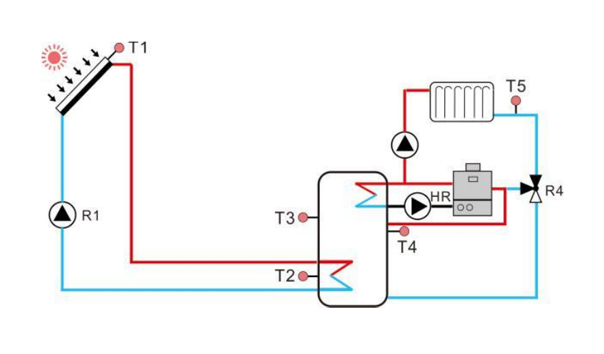Views: 5 Author: Site Editor Publish Time: 2021-11-11 Origin: Site

1. Solar collector
The basic working principle of solar collectors is simple. When sunlight hits the absorber coated with an absorption layer on the surface of the solar collector, most of the solar radiation energy is absorbed by the absorber, converted into heat energy, and transferred to the fluid The temperature of the working fluid in the channel gradually rises, and the heated working fluid brings heat to the water tank through the circulating pipe, and the water in the water tank is heated.
2. Hot water storage tank
Since solar energy is not a stable supply, in order to supply the load demand during rainy days and at night, the water tank is required as heat storage to stably supply the load heat energy. Because solar collectors can only work during the day, and people generally only heat and use hot water at night, the hot water produced by the collector during the day can be stored through the heat preservation water tank to stably supply the load heat energy.
3. Radiating system
The heat dissipation system is a release device that effectively exports heat energy and disperses the heat energy to where it is needed through the heat dissipation system. The heat dissipation forms include wall-mounted, cabinet, floor heating, shed heating, heat sinks, etc., which are often used in engineering It is floor heating type and fin type. The design of the solar heating floor heating system is Sunflower Solar's strength.
4. Control system
The control system is to adjust and coordinate the operation of the entire heating system such as solar collectors and hot water storage tanks, so as to realize an economical and moderate temperature operation scheme. The circulation control system mainly uses temperature sensing probes and other control elements to collect the temperature output signals of each control point to the execution equipment, and transmit the signals to the controller to control the start and stop of the system at any time. The channel that transports hot water from the solar heat collector to the heat preservation water tank and cold water from the heat preservation water tank to the heat collector, so that the whole system forms a closed loop.
5. Pipeline
Reasonable design and correct connection of circulating pipes are crucial to whether the solar heating system can achieve the best working condition. Hot water pipes must be insulated. The pipeline must be of high quality.
6. Auxiliary heat source
Solar heating generally uses a combination of solar collectors and auxiliary heat sources. Solar energy cannot be an independent energy source when the climate changes greatly or when there is no sunshine on cloudy and rainy days. Therefore, it is more common to use gas as an auxiliary heat source for heating. The auxiliary heat source can be electricity, gas, oil, biomass, etc., but generally speaking, it is more economical to use gas as an auxiliary heat source.